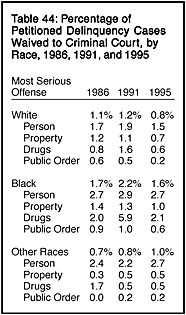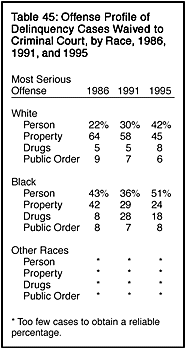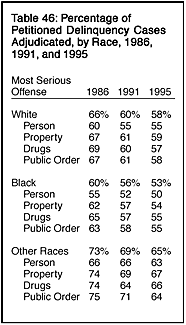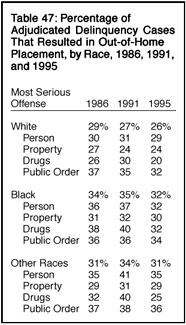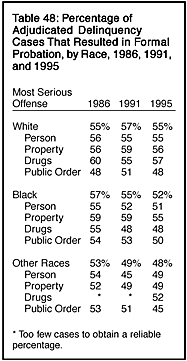|
Race Judicial Decision and Disposition Among both whites and blacks, the use of waiver to criminal court for cases involving drug offenses increased between 1986 and 1991 then declined between 1991 and 1995. The use of waiver in person offense cases involving white youth increased from 1986 through 1994 then dropped so that in 1995 such cases were less likely to be waived than in 1986. The trend in the use of waiver for person offense cases involving black youth was similar although the proportions of cases waived each year were higher.
Compared with 1986, property offense cases in 1995 made up a smaller proportion of all waived cases involving either white or black juveniles (table 45). On the other hand, person offense cases accounted for a growing proportion of waived cases involving white youth (growing from 22% in 1986 to 42% in 1995) or black youth (43% in 1986 compared with 51% in 1995). Among black youth, the proportion of waived cases that involved drug offenses rose substantially from 1986 to 1991 (from 8% to 28%) and then declined to the 1995 level (18%). This shifting in drug cases as a proportion of waived cases was not seen among white youth. In 1995, petitioned cases involving black juveniles were less likely to be adjudicated (53%) than were cases involving white juveniles (58%) or juveniles of other races (65%) (table 46). In fact, cases involving blak juveniles were less likely to be adjudicated once petitioned than those involving other juveniles in all four major offense categories. The likelihood of adjudication for petitioned delinquency cases declined between 1986 and 1995 for all racial groups. In drug cases, for example, the use of adjudication decreased for cases involving white youth (from 69% to 57%), black youth (from 65% to 55%), and youth of other races (from 74% to 66%).
Adjudicated cases involving white youth were less likely to result in out-of-home placement in 1995 (26%) than cases involving black youth (32%) or youth of other races (31%) (table 47). From 1986 through 1995, the use of residential placement declined for cases involving white youth. During the same period, the use of residential placement increased somewhat and then declined for cases involving black youth or youth of other races. Changes in the likelihood of out-of-home placement varied slightly across the four major offense categories within race groups. Substantial variation occurred in the use of residential placement for drug cases for all race groups. Adjudicated delinquency cases involving white juveniles were generally more likely than those involving either black juveniles or youth of other races to result in a disposition of formal probation (table 48). In 1995, 55% of adjudicated cases involving white youth were placed on formal probation (compared with 52% of those involving black youth and 48% of cases involving youth of other races). Between 1986 and 1995, the use of formal probation declined for cases involving either black youth or youth of other races, but remained relatively unchanged for cases involving white youth.
|
